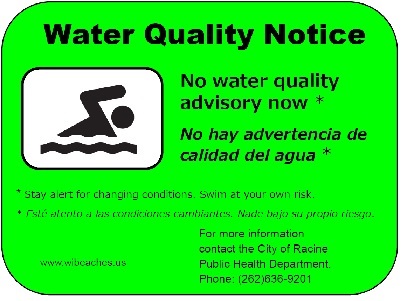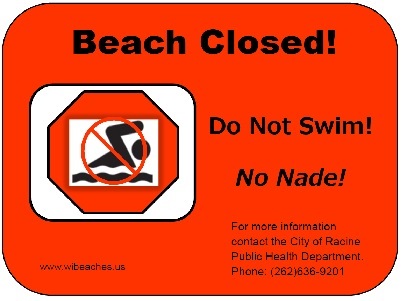Environmental Monitoring
Introduction
The City of Racine Public Health Department Laboratory conducts physical, chemical, and microbiological assessments on stormwater infrastructureThe basic systems and services, such as transportation and power supplies, coastal beaches, inland lakes, and tributaries to protect human and environmental health. Regulatory monitoring assessments use statutory thresholds and recommended guidelines to determine overall quality and risk to the public.
Monitoring E. coli levels is a reliable way to assess the safety of recreational waters, particularly for swimming. E. coli is commonly found in the intestines of humans and other warm-blooded animals, so its presence in water suggests that there may be harmful pathogens or disease-causing bacteria, such as those found in fecal matter. High levels of E. coli indicate a potential health risk for beachgoers, prompting advisories or closures to protect public health.
City of Racine Public Beaches
During the summer, laboratory staff collect water samples from North and Zoo Beaches and gather data that influences water quality, including water clarity, temperature, wave height, recent rainfall, and nearby wildlife. Beach water quality isn’t just about today’s conditions, it’s affected by everything happening in and around the lake. Rainfall in the past 24 to 48 hours is one of the biggest indicators of poor water quality, as stormwater runoff carries contaminants from streets, lawns, and parking lots directly into the lake. Wildlife also plays a role; gulls, for example, are drawn to sandy areas, leaving behind bacteria that can impact water safety. Even wave action stirs up bacteria from the sand and algae, temporarily affecting water quality.
Traditionally, recreational water quality monitoring took 18 to 24 hours for results using culture-based testing methods, meaning that by the time a warning could be issued, conditions might have already changed. Today, the Racine Public Health Department Laboratory is at the forefront of beach monitoring, using a combination of rapid molecular testing (qPCR), machine learning models, and historical data analysis to make faster, more accurate predictions about water quality.
In 2012, the City of Racine Public Health Department Laboratory became the first agency in the US to be given approval to use a rapid, DNA-based laboratory test, qPCR to measure E. coli in water samples collected from North and Zoo Beaches. Within just two hours, the laboratory can determine whether bacteria levels exceed safe thresholds allowing for real-time public health decisions.
Results of the E. coli test are interpreted using regulatory beach action thresholds set by WI DNR and the appropriate, state-approved beach action signage posted at the beach. Beach closures and advisories also consider wind conditions, wave height, and the potential for rip currents.
Beach status explanations are found below.
Green Sign
Fresh bodies of water, such as Lake Michigan beaches, unlike swimming pools, are not treated in any way and there is always some risk attached to swimming. When the green sign is displayed it means that water quality for that day has met US EPA standards of acceptable risk for full body exposure, i.e. putting your head under the water. To reduce your risk of illness and the transmission of disease to those around you: shower before you swim, never swim when you are ill, and wash your hands thoroughly before you eat or drink.
Yellow Advisory
A yellow advisory sign will be posted whenever E. coli levels exceed 235 MPN/100 ml in a single sample, or waves and currents pose a safety hazard. A yellow sign indicates a potential increased risk to human health from exposure to recreational water. While swimming is not prohibited, the Health Department strongly encourages people to enjoy the beach but avoid full body contact with water until the advisory is removed. Certain people should especially avoid contact during these times: very young, elderly, or those with compromised immune systems.
Red Closure
A red closure sign will be posted whenever E. coli levels are equal to or greater than 1000 MPN/100 ml in a single sample, or large waves and currents pose a safety hazard. The red stop sign indicates a risk to human health from contact with surface water and swimming is prohibited. While you may enjoy other activities on the beach, swimming is not allowed. It is important to obey these recommendations to reduce your risk of waterborne illness or drowning.
Harmful Algal Blooms
Blue-green algae (cyanobacteria) occur naturally in freshwater. Under certain conditions, such as warmer water temperatures, high nutrient levels, and plentiful sunshine, they can multiply rapidly to produce a bloom. When there are toxins (cyanotoxins) present in the blooms, they are called harmful algal blooms (HABs). Coming into contact with, inhaling, and/or swallowing water containing the cyanotoxins can cause health problems for people and animals.
There are several characteristics to watch for that indicate the presence of a possible HAB. While only laboratory testing can confirm if toxins are present, avoid any water that shows signs of a HAB. These include:
- The water appears green, like “pea soup”
- The water has a swampy odor
- There are scum, mats, foam, and/or paint-like streaks in the water or on the shore
If the water has any of the above signs, do not go into the water and do not let children or pets play in or drink it. In addition, the Public Health Department Laboratory has signs warning beach visitors about the presence of HABs in Racine. Do not enter the water if one of these signs is posted.
You can also take a look at the CDC for further information on harmful algal blooms.







